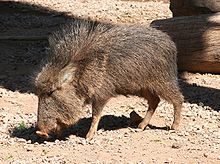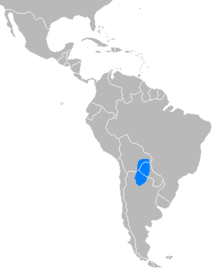Catagonus
| Chacoan peccary | |
|---|---|
 |
|
| At the Phoenix Zoo | |
| Scientific classification | |
| Kingdom: | Animalia |
| Phylum: | Chordata |
| Class: | Mammalia |
| Order: | Artiodactyla |
| Family: | Tayassuidae |
| Genus: |
Catagonus Ameghino, 1904 |
| Species: | C. wagneri |
| Binomial name | |
|
Catagonus wagneri (Rusconi, 1930) |
|
 |
|
| Synonyms | |
|
Parachoerus wagneri Rusconi, 1930 |
|
Parachoerus wagneri Rusconi, 1930
The Chacoan peccary or tagua (Catagonus wagneri) is the last extant species of the genus Catagonus; it is a peccary found in the Gran Chaco of Paraguay, Bolivia, and Argentina. About 3000 exist in the world. It is believed to be the closest living relative to the extinct genus Platygonus.
The Chacoan peccary has the unusual distinction of having been first described in 1930 based on fossils and was originally thought to be an extinct species. In 1971, the animal was discovered to still be alive in the Chaco region, in the Argentine province of Salta. The species was well known to the native people, but it took a while for scientists to acknowledge its existence. It is known locally as the tagua.
The Chacoan peccary is confined to hot, dry areas. Dominated by low-lying succulents and thorny bushes, the Gran Chaco is about 140,000 km2. A few scattered giant trees are found, but the majority of the vegetation is thorny scrub vegetation. The Chacoan peccary has developed adaptations such as well-developed sinuses to combat dry, dusty conditions. Their feet are also small, which allows maneuverability among spiny plants.
The largest of the three generally accepted species of peccaries, the Chacoan peccary has many pig-like features. It is an ungulate with a well-formed rostrum with a tough leathery snout. The bristle-like hair is generally brown to almost gray. A dark stripe runs across the back, and white fur is on the shoulders. Chacoan peccaries differ from other peccary species by having longer ears, snouts, and tails. It has white hairs around the mouth, unlike other peccaries. Catagonus wagneri also has a third hind toe, but other peccaries only have two. The hypsodont teeth follow this dental formula: 2/3, 1/1, 3/3, 3/3 . The upper canines display the distinguishing trait of peccaries, pointing downwards instead of out and up like other Suiformes. When the Chacoan peccary is nervous or frightened, it flees, and raises the hairs on its back. While escaping, it sprays secretions from its dorsal glands, which may be a signal for other peccaries to keep the group together through the dense bush.
...
Wikipedia

